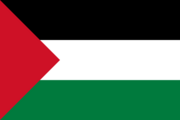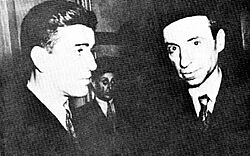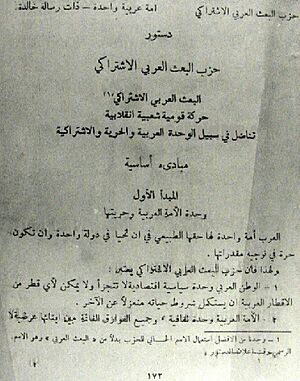Ba'ath Party facts for kids
Quick facts for kids
Arab Socialist Ba'ath Party
حزب البعث العربي الاشتراكي
|
|
|---|---|
| Secretary-General | Michel Aflaq (1954–65) Munif Razzaz (1965–66) |
| Founders | Michel Aflaq Salah al-Din al-Bitar |
| Founded | 7 April 1947 |
| Dissolved | 1966 (as a unified party) |
| Merger of | Arab Ba'ath Arab Ba'ath Movement Arab Socialist Movement |
| Succeeded by | Arab Socialist Ba'ath Party – Iraq Region and Ba'ath Party (Iraqi-dominated faction) Arab Socialist Ba'ath Party – Syria Region and Ba'ath Party (Syrian-dominated faction) |
| Newspaper | Al-Ba'ath |
| Ideology | Ba'athism
|
| Political position | Left-wing |
| Colors | Black White Green Red (Pan-Arab colors) |
| Slogan | "Unity, Freedom, Socialism" "Long Live The Arabs" "A single Arab nation with an eternal mission" |
| Party flag | |
 |
|
| Website | |
| (link dead) | |
The Arab Socialist Ba'ath Party was a political party started in Syria in 1947. Its founders were Michel Aflaq, Salah al-Din al-Bitar, and followers of Zaki al-Arsuzi. The party's main idea was Ba'athism, which combined Arab nationalism, pan-Arabism, and Arab socialism.
Ba'athism called for all Arab countries to unite into one single state. The party's motto was "Unity, Freedom, Socialism." This meant unity for the Arab world and freedom from outside control.
The party was created on April 7, 1947, by joining two groups: the Arab Ba'ath Movement and the Arab Ba'ath. The party soon opened branches in other Arab countries, but it only gained power in Iraq and Syria. In 1952, it merged with the Arab Socialist Movement to become the Arab Socialist Ba'ath Party.
The party became very popular in Syria. In 1958, it helped create the United Arab Republic (UAR), a union between Egypt and Syria. However, the UAR did not last long and ended in 1961.
After the UAR broke up, disagreements grew inside the Ba'ath Party. A group of military officers, called the Military Committee, took control from the party's civilian leaders. In 1963, the Ba'ath Party took power in Syria through a military takeover.
A power struggle began between the civilian leaders, like Aflaq, and the Military Committee, led by Salah Jadid and Hafez al-Assad. In 1966, the Military Committee removed the old leaders from power. This event split the Ba'ath Party into two separate groups: one based in Iraq and one in Syria. After the fall of the Ba'athist government in Syria on December 8, 2024, there are no longer any countries ruled by the Ba'ath Party.
Contents
The Party's Main Ideas
The Ba'ath Party's ideas were written down in its constitution in 1947. The main belief was that all Arabs are part of one nation and should live in a single country. This idea is called pan-Arabism.
The party's founder, Michel Aflaq, believed in "one Arab nation with an eternal message." This meant that the Arab identity was very important to history. The party's ideas were not based on race but on shared culture and language.
Unity, Freedom, and Socialism
The party's slogan, "Unity, Freedom, Socialism," explained its main goals.
- Unity meant creating a single, strong Arab nation.
- Freedom meant freedom from the control of other countries, as well as freedom of speech and thought.
- Socialism referred to a special form of Arab socialism. It focused on freeing the Arab people from poverty and outside control. It did not originally have detailed plans for the economy.
Over time, the party's ideas changed. After the United Arab Republic failed, some members began to focus more on socialism than on Arab unity. At the party's 6th National Congress in 1963, new ideas were introduced. These ideas were influenced by Marxism and called for more government control over the economy, such as creating collective farms and giving workers more power.
This shift in ideas caused disagreements between the party's old leaders and a new, more radical group.
History of the Ba'ath Party
The Ba'ath Party was founded in Damascus, Syria, on April 7, 1947. Its founders came from different religious backgrounds. Michel Aflaq was a Christian, Salah al-Din al-Bitar was a Sunni Muslim, and Zaki al-Arsuzi's followers were also involved.
The party quickly grew and set up branches in other Arab countries like Iraq, Yemen, and Jordan. In the 1954 Syrian elections, the Ba'ath Party won 22 seats in parliament, making it the second-largest party in the country. This success helped it push for a union with Egypt, leading to the United Arab Republic (UAR) in 1958.

The UAR was not successful and ended after a military takeover in Syria in 1961. This event caused a lot of debate within the Ba'ath Party.
Power in Syria and the 1966 Split
In 1963, the Ba'ath Party took power in Syria in another military takeover. From then on, it was the only official political party in the country. However, there were many disagreements within the party.
A powerful group of army officers, known as the Military Committee, had been formed in secret. This group, led by figures like Salah Jadid and Hafez al-Assad, had different ideas from the party's original founders, Aflaq and al-Bitar.
The conflict between the Military Committee and the old leaders grew. On February 23, 1966, the Military Committee launched a takeover and removed Aflaq and his supporters from power. This event caused a permanent split in the Ba'ath Party.
After the split, two rival Ba'ath parties were created:
- One was based in Syria and led by the new military leaders.
- The other was based in Iraq and remained loyal to the old leadership.
These two parties became rivals and often disagreed with each other.
The Ba'ath Party in Different Countries
Iraq
The Iraqi branch of the Ba'ath Party was founded in 1951 or 1952. At first, many of its members were Shia Muslims, but it later became dominated by Sunni Muslims.
In 1958, the party supported the revolution that overthrew the monarchy in Iraq. They hoped the new leader, Abdul-Karim Qasim, would join the UAR. When Qasim decided against it, the Ba'ath Party turned on him. An attempt to remove him from power in 1959, involving a young Saddam Hussein, failed.
In 1963, the Ba'ath Party took power in Iraq in the Ramadan Revolution. However, due to internal conflicts, they were removed from power just a few months later. The party went underground but eventually returned to power in 1968.
Syria
In 1954, the Ba'ath Party became the second-largest party in the Syrian parliament. It was very popular, especially among intellectuals and workers, because it opposed foreign influence and supported social reforms.

The party's main rival was the Syrian Communist Party. To counter the Communists' growing strength, the Ba'ath Party pushed for the union with Egypt in 1958, creating the UAR. During the UAR, the Ba'ath Party was officially dissolved.
After a military takeover ended the UAR in 1961, the Ba'ath Party was re-formed. In 1963, the party's Military Committee took power in Syria. This led to decades of Ba'athist rule in the country, which ended with the Fall of the Assad regime on December 8, 2024. The party officially suspended its activities in Syria three days later.
Jordan
Ba'athist ideas became popular in Jordan in the late 1940s, especially at universities. The official party branch was formed in 1951. It was most active in cities like Jerusalem, Ramallah, Irbid, and Amman.
In the 1950s, the party managed to get some of its members elected to the Jordanian parliament. However, the party was later banned, and its leaders faced challenges from the government.
Lebanon
The Lebanese branch of the Ba'ath Party was formed around 1949. It was strongest in the city of Tripoli. Like other branches, it experienced splits and disagreements, especially over whether to support Egypt's leader, Gamal Abdel Nasser.
The party in Lebanon became known for its more radical socialist views. After the 1966 split, the Lebanese branch had to choose between the Syrian-led and Iraqi-led factions.
See also
 In Spanish: Partido Baaz Árabe Socialista para niños
In Spanish: Partido Baaz Árabe Socialista para niños


